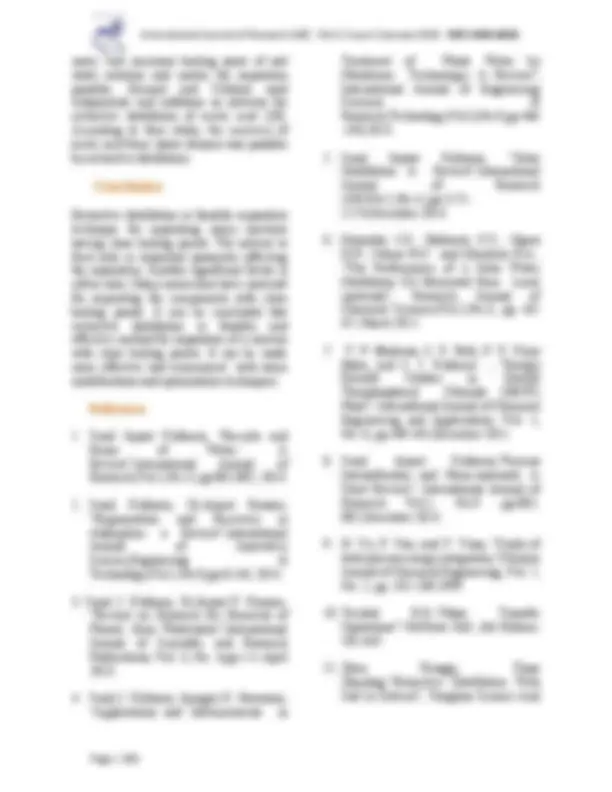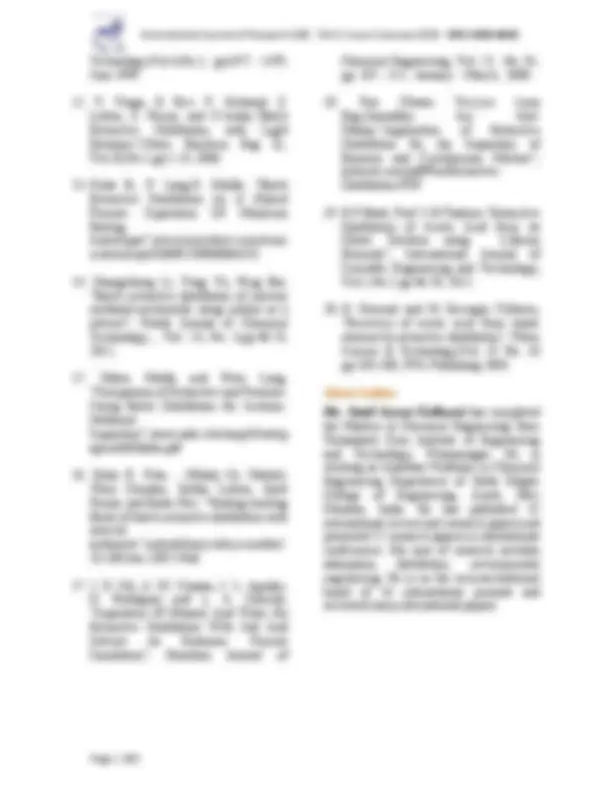




Study with the several resources on Docsity

Earn points by helping other students or get them with a premium plan


Prepare for your exams
Study with the several resources on Docsity

Earn points to download
Earn points by helping other students or get them with a premium plan
Community
Ask the community for help and clear up your study doubts
Discover the best universities in your country according to Docsity users
Free resources
Download our free guides on studying techniques, anxiety management strategies, and thesis advice from Docsity tutors
About Distillation
Typology: Exercises
1 / 4

This page cannot be seen from the preview
Don't miss anything!



Sunil Jayant Kulkarni1* 1*Chemical Engineering Department, Datta Meghe College of Engineering, Airoli, Navi Mumbai, Maharashtra, India. *E-mail: suniljayantkulkarni@gmail.com
Distillation is one of the most important separation technique used in chemical industries. Many times it is desired to separate the components having similar boiling points. The relative volatility of such mixture is close to 1 and the separation is almost impossible. In such cases, extractive distillation comes as a tool to alter the relative volatility and make the separation possible. Various parameters affecting the extractive distillation includes the solvent to feed ratio and reflux ratio. For the reduction in energy consumption, it is necessary to operate the process at low reflux ratio. Also the addition of salt can alter the boiling point as the salt also brings about the deviation in boiling point. In many cases it was possible to reduce reflux ratio and number of plates by using salt. In this review the studies and research on extractive distillation is summarized.
Solvent; reflux; stages; batch; relative volatility
Separation techniques are important part of the chemical industries. The separation processes are also important part of environmental engineering studies [1, 2, 3]. These techniques have been used in the modified way such as solar distillation, membrane distillation, pervaporation etc. [4, 5, 6]. The conventional techniques are modified from process intensification point
of view by using pinch techniques, using nanopartilces and combining two processes like reactive chromatography, reactive distillation etc.[7,8,9].Distillation is a major unit operation used for separation of compounds with different boiling points. Many product recovery and purification operations include distillation. Disillation has advantages such as high purity and direct separation of end product. Extraction also is a major unit operation, which is based on different miscibility of the components[10].The advantages are less energy requirement and wide range of options in terms of solvent selection. Being an indirect operation, the disadvantage of this operation is, the need of further separation of solvent from the solute. Distillation becomes ineffective when the boiling points of the components are very close or the relative volatility is close to unity. In such cases extractive distillation can be used as a separation technique. In this technique, solvent is added to the mixture, which alters the relative volatility of the solvent- feed solvent mixture relative to the solute. This makes the separation possible. Also addition of salt helps in this objective. In the current review the studies and research carried out on extractive distillation, with and without addition of salt and modifications of the extractive distillation are summarized.
Research and Advancements in Extractive Distillation
Rongqi and Zhanting used new process for producing anhydrous ethanol [11]. They combined the principle of salt effect and some traditional extractive distillation methods. They observed the salt effects for the solvents such as AICI 3 , CaC 2 , NaCl, Al ( NO 3 ) 3 , Cu(NO 3 ) 2 and KNO 3. It was observed that the relative volatility increased by about 30 percent after addition of small amout of salt to the solvent. Use of salt in solvent instead of only ethylene glycol was more beneficial. It improved efficiency, reduced solvent ratio and the number of necessary plates. In case of conventional extractive distillation, the energy and equipment cost was high due to the solvent feed ratio of 5:1. Such draw backs can be removed in this new method. Feasibility of batch extractive distillation with light entrainer for separating minimum and maximum boiling azeotropes and close boiling mixtures was studied by Varga et.al. [12].They used the systems such as ethanol/water (minimum boiling azeotrope) with methanol, water/ethylene diamine (maximum boiling azeotrope)with methanol, chloroben-zene/ethylbenzene (close boiling mixture)with 4-methylheptane. According to them, when continuous entrainer is to be applied , it is preferred to feed in cold conditions. Kotai et.al. compared batch extractive distillation process with the hybrid process (absorption + distillation) [13]. According to their study, batch extractive distillation (BED) offers higher degree of freedom, greater flexibility and can produce better results than the hybrid process. Li et.al. used aniline as a solvent for batch extractive distillation of mixture methanol-acetonitrile[14].They obtained the optimal parameters and configuration of the extractive distillation column with minimal energy requirements. They carried out sensitivity analysis for various parameters.
They observed that solvent feed rate was in close relationship with the reflux ratio in batch extractive distillation. Modla and Lang compared pressure swing and extractive distillation [15]. They used acetone(A)- methanol(B) system with azeotropic composition(PSBD). In batch extractive distillation (BED), water was used as a solvent. In all BED policies higher recovery of acetone(A) was achieved than by the PSBD.The BED method needed more number of steps. Control of double column batch stripper(DCBS) was easier, but cost involved was more. Frits et.al. carried out studies aimed at finding out limiting flows of batch extractive distillation [16]. They used graphical tools to estimate limiting flow values. They applied interval arithmetic with branch and bound technique for the singular points and bifurcations. Gil et.al carried out process simulation studies for separation of ethanol and water by extractive distillation with salt and solvent as entrainer [17].They used NRTL equations for calculation of activity coefficient for ethanol
Technology,Vol.4,No.2, pp.l477- 1479, June 1999.
Chemical Engineering, Vol. 25, No. 01, pp. 207 - 215, January - March, 2008.
About Author Mr. Sunil Jayant Kulkarni has completed his Masters in Chemical Engineering from Tatyasaheb Kore Institute of Engineering and Technology, Warananagar. He is working as Assistant Professor in Chemical Engineering Department of Datta Meghe College of Engineering, Airoli, Navi Mumbai, India. He has published 35 international review and research papers and presented 15 research papers in international conferences. His area of research includes adsorption, distillation, environmental engineering. He is on the reviewer/editorial board of 16 international journals and reviewed many international papers.